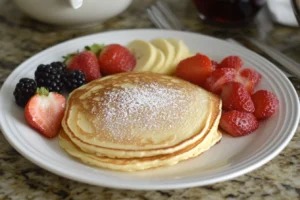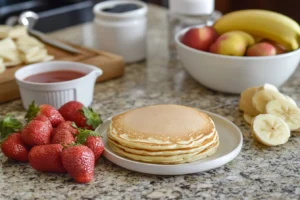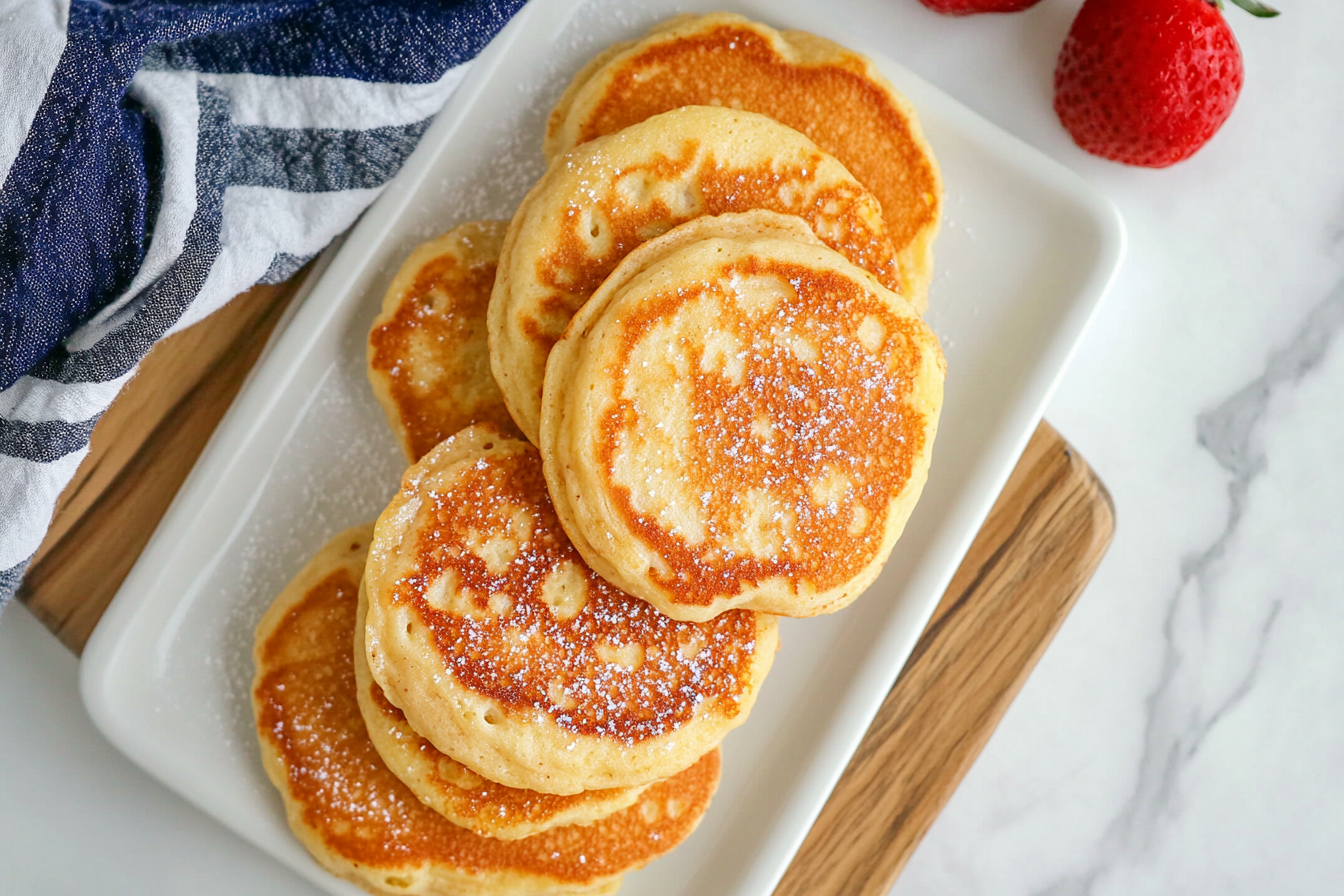Initiation: Protein Pancakes Without Protein Powder
Protein pancakes are a delicious and nutritious way to start your day; however, many recipes rely on protein powder. If you’re looking for a more natural approach, making protein pancakes without protein powder is an excellent choice. You can still create pancakes that are just as high in protein and more flavorful and wholesome using whole, natural ingredients. This guide will examine making protein-packed pancakes using everyday kitchen staples, ensuring a healthy and balanced breakfast.
Benefits of Homemade Protein Pancakes Without Protein Powder
Creating your own protein pancakes at home offers several advantages.

First and foremost, you have complete control over ingredients, allowing you to avoid artificial additives often found in commercial products. Additionally, it’s more cost-effective since you can skip expensive protein powders and use affordable pantry staples instead. Moreover, homemade recipes provide excellent nutritional value, as they let you include natural protein sources rich in vitamins, minerals, and fiber. Furthermore, they are allergy-friendly, allowing you to adapt the recipes to exclude allergens like dairy, gluten, or nuts based on your dietary needs.
By transitioning to protein pancakes without protein powder, you also embrace cleaner eating habits, which supports long-term health goals.
Key Ingredients for Natural Protein Sources
Building protein-packed pancakes without using protein powder begins with the right ingredients. Some excellent natural protein options include:
- Eggs are a rich source of complete proteins and essential nutrients like choline, which support overall health.
- Greek yogurt: It provides a creamy texture and delivers high-quality protein.
- Cottage cheese adds moisture to the batter while significantly boosting the protein content.
- Oats: A versatile, plant-based option high in fiber, helping sustain energy throughout the day.
- Nuts and seeds: Almond butter, chia seeds, or flaxseeds contribute additional protein and healthy fats.
By using these ingredients, you can improve the protein content of your pancakes while adding depth to their flavor and texture.
Choosing the Right Flour for Protein Pancakes Without Protein Powder
The type of flour you choose plays a critical role in your pancake recipe. While traditional all-purpose flour is standard, there are better options for protein pancakes without protein powder.
For instance, whole wheat flour is fiber-rich and slightly higher in protein than white flour. Similarly, oat flour is a naturally gluten-free option (when certified) that is nutrient-dense and works well in many recipes. On the other hand, almond flour is a low-carb, protein-packed alternative that provides a subtle nutty flavor. Additionally, quinoa flour offers a high-protein, gluten-free option for health-conscious eaters.
By choosing alternative flours, you improve the nutritional profile and improve the texture and flavor of your pancakes. For more inspiration, check out sweet cream pancakes, which focus on balance and simplicity.
Liquid Ingredients to Boost Protein Pancakes Without Protein Powder
Liquid ingredients are essential for balancing the batter and adding nutrients. Here are some excellent options to consider:
- Milk or plant-based milk: Cow’s milk provides good protein, while almond or soy milk is a dairy-free alternative with additional protein benefits.
- Greek yogurt: When thinned with water, it can double as a liquid ingredient, offering a creamy texture alongside its nutritional value.
- Egg whites: These are perfect for increasing protein content without adding fat.
Each liquid ingredient contributes unique nutritional benefits, ensuring that your pancakes are as healthy as they are delicious.
Sweeteners for Healthy Protein Pancakes Without Protein Powder
Sweetening your pancakes naturally is a great way to avoid blood sugar spikes caused by refined sugars. For example, consider these options:
- Mashed bananas: Not only do they add natural sweetness, but they also provide potassium, which supports heart health.
- Applesauce: This low-calorie option is rich in vitamins and works as a healthy sweetener.
- Honey or maple syrup: Both are natural sweeteners providing trace minerals.
- Stevia or monk fruit extract: These zero-calorie options work well for those on a low-sugar diet.
Using natural sweeteners insures that your protein pancakes remain nutritious and delicious without protein powder.
Improve Flavor Naturally
To make your pancakes truly irresistible, it’s essential to improve their flavor with natural additions. Here are a few suggestions:

- Spices: Add cinnamon, nutmeg, or vanilla extract to introduce warm and aromatic flavors.
- Fresh fruits: Blueberries, raspberries, or grated apples add sweetness and boost antioxidants to your pancakes.
- Cocoa powder: A small amount of unsweetened cocoa transforms your pancakes into a chocolatey treat.
- Coconut flakes or zest: These ingredients add texture and a tropical flair to your breakfast.
By incorporating natural flavor increasers, you can keep your pancakes exciting without the need for artificial additives. For a savory twist, see how pairing with meals like Caesar salad with chicken can create a protein-rich, balanced meal.
Substituting Protein Powder in Recipes
If you’re adapting a traditional protein pancake recipe, substituting protein powder is simple and effective.
To start, you can replace protein powder with whole ingredients:
- For every scoop of protein powder, substitute:
- 2 tablespoons of almond flour or oats.
- 1/4 cup of Greek yogurt or cottage cheese.
Next, adjust the liquid ingredients: Since protein powders absorb moisture, you may need to reduce the liquid slightly when making substitutions.
Finally, boost the protein content naturally:
- Add an extra egg or 2 tablespoons of chia seeds to the batter for a similar protein level.
With these adjustments, you’ll enjoy pancakes that deliver comparable protein levels without compromising flavor or texture.
Making protein pancakes without protein powder is a satisfying and health-conscious choice. By relying on natural protein sources and nutrient-rich ingredients, you can create a balanced breakfast that fuels your body while delighting your taste buds. Experiment with different combinations, and you’ll find that wholesome, protein-rich pancakes are as easy to prepare as they are to enjoy.
Protein pancakes without protein powder offer a natural, healthy, and delicious breakfast option. By using simple ingredients, you can craft pancakes that are nutrient-dense and easy to prepare. With a bit of creativity, you can customize your recipe to suit your preferences, whether you’re inspired by classic recipes or newer ideas like French toast pancakes.
Recipe for Basic Protein Pancakes Without Protein Powder
Creating protein pancakes without protein powder is simple and rewarding. To start off here’s a foolproof recipe to get started:
Ingredients:
- 1 cup rolled oats
- 2 large eggs
- 1 ripe banana
- 1/4 cup Greek yogurt
- 1/2 teaspoon baking powder
- 1/2 teaspoon cinnamon (optional)
- A pinch of salt
Instructions:
- First, blend the oats in a blender to create oat flour.
- Next, add the banana, eggs, Greek yogurt, baking powder, cinnamon, and salt to the blender. Blend until smooth.
- Then, preheat a non-stick skillet over medium heat and lightly grease it.
- Pour 1/4 cup of the batter onto the skillet for each pancake.
- After that, cook for 2-3 minutes until bubbles form, then flip and cook for another 1-2 minutes.
- Finally, serve warm with your favorite toppings.
Variations on Protein Pancake Recipes
Add a nutty boost:
- Include 1-2 tablespoons of almond or peanut butter in the batter.
Infuse with chocolate flavors:
- Add 1-2 teaspoons of cocoa powder and a handful of dark chocolate chips.
Incorporate fruits and berries:
- Mix in blueberries, diced apples, or shredded zucchini for added nutrients.
Make it vegan:
- Replace eggs with flaxseed or chia seed mixtures (1 tablespoon seeds + 3 tablespoons water per egg).
- Use plant-based yogurt instead of Greek yogurt.
As you can see, these variations allow you to tailor the recipe to your preferences.
Tips for Fluffy Pancakes
To achieve fluffy protein pancakes without protein powder, keep the following tips in mind:
- First, don’t overmix: Overmixing can lead to dense pancakes. Blend ingredients just until smooth.
- Moreover, use fresh baking powder: Expired baking powder won’t provide enough rise.
- Additionally, let the batter rest. Allow it to sit for 5 minutes before cooking.
- Finally, cook on medium heat: High heat can burn the pancakes without cooking the center.
Cooking Methods of Protein Pancakes Without Protein Powder
Stovetop:
- The classic method. Preheat a non-stick skillet and cook as per the basic recipe.
Oven:
- Pour the batter into a greased muffin tin and bake at 350°F (175°C) for 15-20 minutes for pancake muffins.
Griddle:
- Perfect for making multiple pancakes at once. Assure even heat distribution and flip when bubbles form.
Each method has its own unique benefits.
Meal Prep and Storage
Meal Prep:
- Double or triple the recipe to make a batch for the week.
Storage:
- Refrigerate: Store in an airtight container for up to 5 days.
- Freeze: Layer pancakes between parchment paper and freeze for up to 2 months.
Reheating:
- Microwave: Heat for 30-60 seconds.
- Oven: Warm at 300°F (150°C) for 5-10 minutes.
In conclusion, proper storage insures that you can enjoy these pancakes anytime.
Nutritional Analysis
For a serving of 3 pancakes (based on the basic recipe):
- Calories: 250-300
- Protein: 12-15g
- Carbohydrates: 30-35g
- Fats: 5-7g
- Fiber: 4-6g
These protein pancakes without protein powder provide a balanced macronutrient profile. They are rich in vitamins and minerals like potassium, calcium, and magnesium. As a result, they make a healthy choice for breakfast or a snack.
Serving Suggestions for Protein Pancakes Without Protein Powder
Classic Toppings:
- Maple syrup
- Fresh berries
- Sliced bananas
High-protein Add-ons:
- A dollop of Greek yogurt
- Sprinkle of chopped nuts
- Drizzle of almond butter
Sweet and Savory Combos:
- Serve with scrambled eggs and avocado for a balanced meal.
- Pair with turkey bacon for an extra protein punch.
With these options, you can customize your pancakes to suit any taste.
Common Mistakes and How to Avoid Them
Batter too thin or thick
- Solution: Adjust by adding more oats (thick) or milk (thin).
Pancakes sticking to the pan
- Solution: Use a non-stick pan and grease lightly.
Uneven cooking
- Solution: Maintain medium heat and cook pancakes of uniform size.
Dense pancakes
- Solution: Insure your baking powder is fresh and avoid overmixing.
By avoiding these pitfalls, your pancakes will turn out perfectly every time.
FAQs About Protein Pancakes Without Protein Powder
Can I make these gluten-free?
Yes, use certified gluten-free oats.
How can I add more protein?
Incorporate cottage cheese or an extra egg.
Can I skip the banana?
Yes, replace it with 1/3 cup applesauce or pumpkin puree.
Are these suitable for kids?
Absolutely! These pancakes are naturally sweetened and nutritious. In short, they’re a hit with all ages.
Making protein pancakes without protein powder in conclusion, is a delightful and nutritious way to start your day. Whether you stick to the basic recipe or experiment with variations, these pancakes are versatile, easy to prepare, and perfect for meal prep. Furthermore, with tips for achieving fluffy results, proper storage methods, and serving ideas, you’re set to enjoy these wholesome pancakes anytime. To summarize, prioritize quality ingredients, avoid common mistakes, and savor every bite of these healthy creations.

